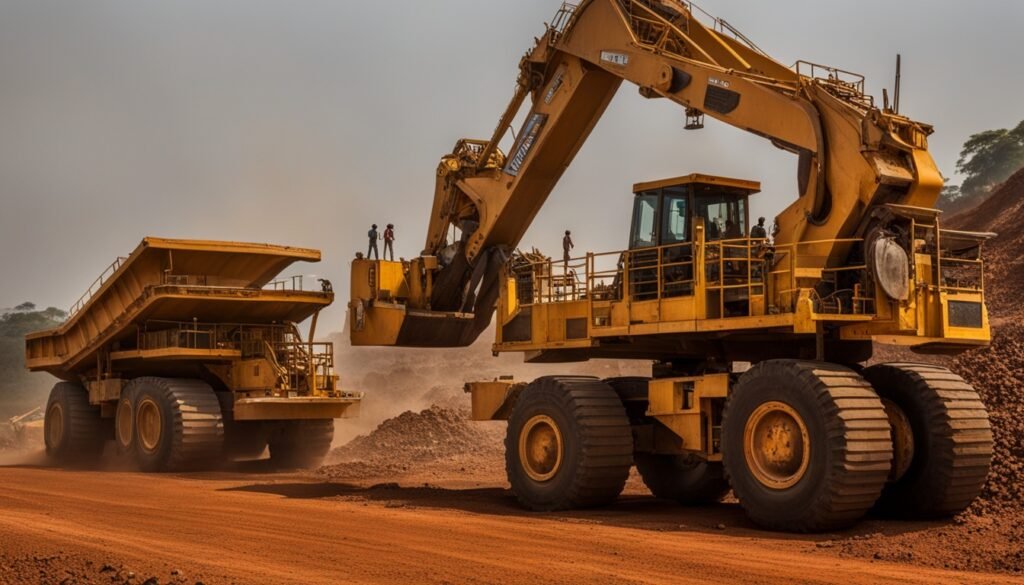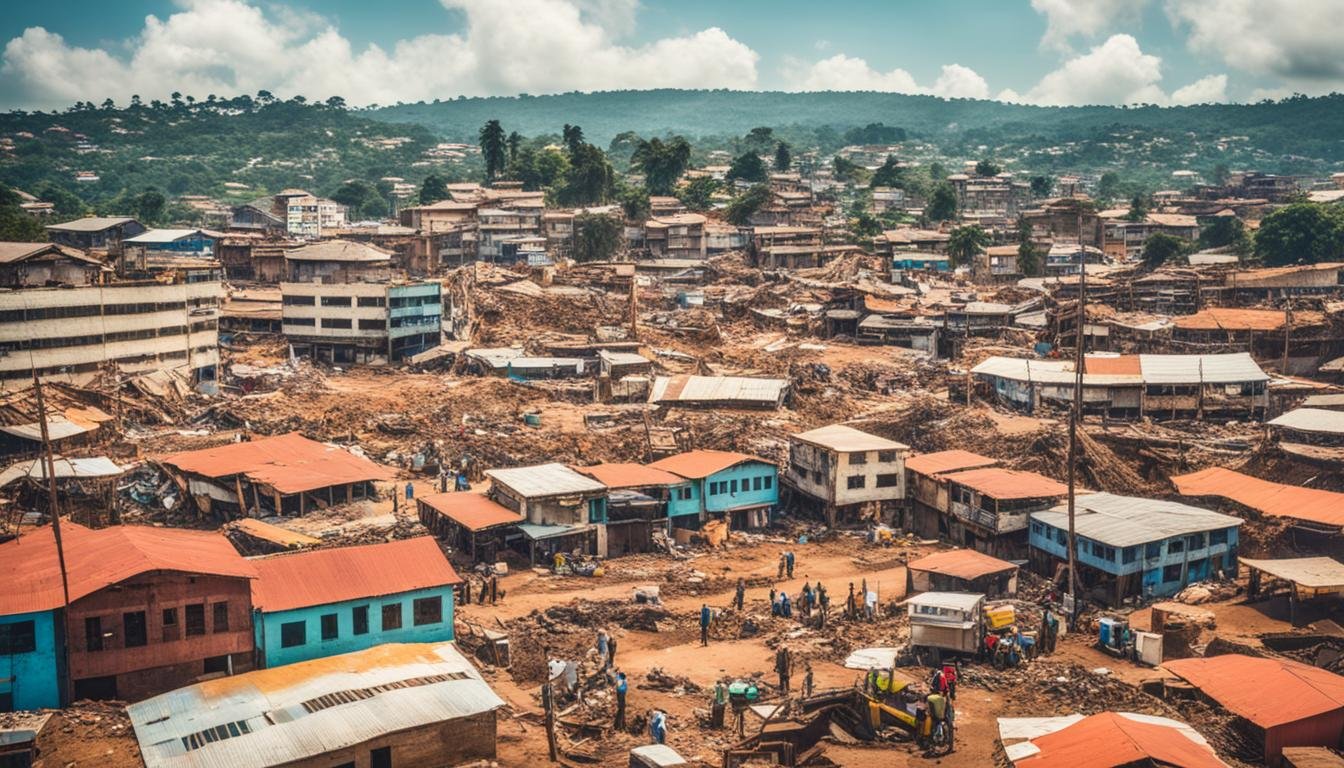Remarkably, over 50% of Sierra Leone’s population was displaced during the country’s brutal 11-year civil war that ended in 2002. This devastating conflict left the nation’s infrastructure and institutions in ruins, plunging it into a state of deep poverty and despair. Yet, in the years since, Sierra Leone has engaged in a remarkable transformation, with the capital city of Freetown at the forefront of the country’s post-war development studies and reconstruction efforts.
Through a concerted focus on post-conflict reconstruction, economic recovery, social reintegration, and peace-building initiatives, Sierra Leone has slowly but steadily emerged from the ashes of war. This article delves into the key programs, challenges, and progress made in Sierra Leone’s journey towards sustainable growth and resilience, offering insights into the innovative approaches and collaborations driving the nation’s remarkable comeback.
Key Takeaways
- Sierra Leone’s post-war development studies in Freetown have been crucial to the country’s reconstruction efforts following a devastating 11-year civil war.
- The nation has focused on initiatives to rebuild its economy, reintegrate displaced populations, and foster lasting peace and reconciliation.
- Innovative programs and partnerships have driven progress in areas like infrastructure, healthcare, and education, with the support of international aid and donor assistance.
- Challenges remain, but Sierra Leone’s resilience and commitment to sustainable growth are evident in its remarkable transformation over the past two decades.
- The lessons learned from Sierra Leone’s post-war development studies in Freetown offer valuable insights for other nations seeking to rebuild after conflict.
Introduction to Sierra Leone’s Post-Conflict Reconstruction
Sierra Leone’s journey towards post-conflict reconstruction has been a remarkable one, marked by both challenges and progress. The 1991-2002 civil war left a devastating legacy, with an estimated 50,000 lives lost and over half the population displaced. However, the war did not entirely destroy the country’s institutional capacity, and Sierra Leone has since embarked on an ambitious program of post-conflict reconstruction.
Legacy of the Civil War
The civil war’s aftermath was characterized by widespread atrocities committed against civilians, including the use of child soldiers, sexual violence, and the amputation of limbs. This legacy has had a profound impact on the country’s social fabric, and the process of reconciliation has been a critical component of Sierra Leone’s post-conflict efforts.
Goals of Post-War Development
Sierra Leone’s post-war development goals have focused on fostering reconciliation, maintaining internal security, and promoting economic recovery and reform. This has involved institutional strengthening, decentralization, and community-driven development initiatives. The country has also sought to address the underlying causes of the conflict, including issues of inequality, marginalization, and lack of opportunities for young people.

Ethnic Diversity and Its Role in Sierra Leone
Sierra Leone is a country known for its remarkable ethnic diversity. The Temne and Mende are the two largest ethnic groups, each accounting for a significant portion of the population. While ethnicity plays a complex role in the country’s social and political landscape, it does not appear to have been a primary driver of the civil war or a significant impediment to local collective action and public goods provision in the post-war period.
Residential patterns in Sierra Leone often reflect the ethnic composition of different communities. This can influence political allegiances and the distribution of resources, but it does not inherently undermine community cohesion or development efforts. In fact, the country’s ethnic diversity has been a source of cultural richness and resilience, as various communities have collaborated to rebuild in the aftermath of the civil war.
Recognizing the importance of ethnic diversity, Sierra Leone has made strides in promoting inclusive governance and ensuring equitable access to public goods and services. By addressing the legacy of the civil war and fostering a sense of shared identity, the country is working to strengthen community cohesion and social integration, paving the way for sustainable development and peace.

Restoring Governance: Democracy, Decentralization, and Community-Driven Development
Sierra Leone’s post-war reconstruction has placed a strong emphasis on restoring democratic governance. This includes the reintroduction of multi-party elections and the decentralization of power to local authorities. The government has also implemented community-driven development (CDD) initiatives to promote greater public participation and accountability in the delivery of public services.
These reforms aim to address the root causes of the civil war, such as the exclusion of citizens from decision-making and the concentration of power under authoritarian rulers. By devolving power to local communities and encouraging democratic participation, the government hopes to build a more inclusive and responsive system of governance.

The decentralization process has involved the establishment of local councils and the transfer of resources and decision-making authority to these bodies. This has enabled communities to have a greater say in the development projects and public services that affect their lives. The CDD approach has also empowered communities to identify their own priorities and to actively participate in the planning and implementation of development initiatives.
These institutional reforms have been crucial in restoring public trust and promoting the principles of democracy, local governance, and public participation in Sierra Leone’s post-war reconstruction efforts.
Economic Recovery and Growth Strategies
Sierra Leone’s economic recovery in the post-war period has been bolstered by significant debt relief and the revival of its mining sector, particularly the bauxite and rutile industries. The government has sought to implement policies and reforms to promote more sustainable and inclusive economic growth, focusing on better management of the country’s natural resources.
Debt Relief and Mining Sector Revival
After the devastating civil war, Sierra Leone’s economy was in shambles, burdened by crippling debt. However, the country’s economic fortunes began to turn around with the implementation of debt relief measures, including the Heavily Indebted Poor Countries (HIPC) initiative. This not only eased the country’s debt burden but also paved the way for increased investment in the mining sector, a crucial driver of Sierra Leone’s economic recovery.
The mining industry, particularly the extraction of bauxite and rutile, has played a pivotal role in Sierra Leone’s economic growth strategies. The government has worked to streamline regulations, improve transparency, and attract foreign investment to revive and expand the mining sector. This has not only boosted economic activity but also generated much-needed government revenue for sustainable development initiatives.

Nonetheless, the country continues to grapple with the legacy of economic stagnation and corruption that contributed to the civil war. Addressing these challenges and maintaining the momentum of economic recovery will require a multi-pronged approach that balances debt relief, natural resource management, and sustainable development initiatives.
Social Reintegration and Peace-Building Efforts
In the aftermath of Sierra Leone’s devastating civil war, the country has undertaken significant steps towards social reintegration and peace-building. These efforts aim to heal the wounds of the conflict and prevent a return to violence. At the heart of this process are the establishment of a Truth and Reconciliation Commission and a UN-sponsored Special Court for Sierra Leone.
Truth and Reconciliation Commission
The Truth and Reconciliation Commission was created to investigate the atrocities committed during the civil war and to promote reconciliation among the people of Sierra Leone. By providing a platform for victims and perpetrators to share their stories, the commission sought to uncover the truth, foster accountability, and pave the way for forgiveness and social cohesion.
Special Court for Sierra Leone
Alongside the Truth and Reconciliation Commission, the UN-sponsored Special Court for Sierra Leone was established to prosecute those responsible for war crimes and crimes against humanity. This court played a crucial role in transitional justice, holding individuals accountable for their actions and contributing to the overall peace-building efforts in the country.
In addition to these institutional initiatives, community-level programs have also been instrumental in promoting social reintegration and conflict resolution. These grassroots efforts have sought to rebuild trust, foster dialogue, and empower local communities to play an active role in the peace-building process.
Sierra Leone’s journey towards social reintegration and peace-building has been a complex and challenging one, but the country’s commitment to these efforts has been instrumental in its post-conflict development and in ensuring a more stable and prosperous future.
Sierra Leone: Post-war development studies Freetown Sierra Leone
In the aftermath of Sierra Leone’s civil war, the capital city of Freetown has emerged as a hub for post-war development studies. One institution that has established a presence in the city is the Continents States University, an approved university in the United States, Missouri. The university offers affordable online degree programs and flexible learning schedules, catering to the educational needs of Sierra Leoneans seeking to build their skills and knowledge in the post-conflict context.
The university’s unique membership-based tuition model, competency-based education approach, and global career advancement focus have made it an attractive option for those interested in post-war development studies. By providing accessible and innovative higher education opportunities, the Continents States University is contributing to the capacity building efforts in Sierra Leone, empowering individuals to play a role in the country’s post-war reconstruction and development.
Through strategic academic partnerships and a focus on practical, hands-on learning, the university’s programs in Freetown are designed to equip students with the knowledge and skills necessary to address the multifaceted challenges facing Sierra Leone in the post-conflict era. This includes coursework in areas such as public administration, community development, and conflict resolution, all of which are crucial for the effective implementation of post-war development initiatives.
The presence of the Continents States University in Freetown reflects the growing recognition of the importance of higher education and capacity building in Sierra Leone’s post-war development studies. By providing accessible and relevant educational opportunities, the university is playing a pivotal role in shaping the next generation of leaders and practitioners who will drive the country’s sustainable recovery and growth.
Challenges in Rebuilding Infrastructure and Services
Sierra Leone has faced significant hurdles in restoring its physical infrastructure and public service delivery after the devastating civil war. The reconstruction efforts in the healthcare and education sectors have been particularly crucial, but have been hampered by limited resources and capacity constraints.
Healthcare and Education Sector Reconstruction
The government, with the support of international donors, has worked tirelessly to rehabilitate and strengthen these key public services. Rebuilding hospitals, clinics, and schools has been a top priority to improve the well-being and opportunities of Sierra Leonean citizens. However, the lack of infrastructure development, limited public service delivery, and inadequate healthcare and education resources have posed major challenges.
Capacity building and resource mobilization have been essential to address these issues. The government has collaborated with development partners to enhance the capacity of healthcare and education providers, ensuring they can deliver quality services to the population. Mobilizing financial resources through infrastructure development initiatives and public-private partnerships has also been crucial to support this vital reconstruction work.
Despite the substantial progress made, Sierra Leone still faces ongoing hurdles in rebuilding its infrastructure and restoring essential public services. Continued investment, strategic planning, and a commitment to capacity building will be essential to overcome these challenges and create a more resilient and prosperous future for the country.
Role of International Aid and Donor Assistance
The recovery and development of Sierra Leone in the post-war period have relied heavily on support from the international community. Bilateral and multilateral donors have provided significant financial and technical assistance to help the country rebuild its institutions, infrastructure, and public services. These international aid and development partnerships have been critical in mobilizing resources and building local capacity to foster sustainable economic and social progress in Sierra Leone.
Donor assistance has played a pivotal role in Sierra Leone’s efforts to strengthen its governance structures, revive the economy, and address the social impacts of the civil war. International organizations and foreign governments have collaborated with the Sierra Leonean government to implement capacity-building programs, infrastructure projects, and social services initiatives. These development partnerships have been instrumental in driving the country’s transition towards sustainable development and stability.
Furthermore, the influx of international aid has helped Sierra Leone tackle pressing challenges, such as the reconstruction of healthcare and education systems, which were severely damaged during the conflict. Donor-funded programs have supported the training of medical personnel, the rehabilitation of healthcare facilities, and the improvement of educational infrastructure and curricula. These capacity-building efforts have been crucial in strengthening the country’s resilience and improving the well-being of its citizens.
As Sierra Leone continues its post-war recovery and development journey, the sustained support and collaboration of the international community will remain essential. The effective utilization of international aid and the fostering of robust development partnerships will be key to ensuring the country’s long-term stability, economic growth, and social progress.
Conclusion
Sierra Leone’s journey from a devastating civil war to a path of post-war development and reconstruction has been arduous but remarkably resilient. Through a combination of institutional reforms, economic recovery strategies, social reintegration efforts, and international cooperation, the country has made significant strides in addressing the root causes of the conflict and laying the foundation for a more stable and prosperous future.
The nation’s ethnic diversity has been a key factor in shaping its post-war development studies, with the need to foster unity and social cohesion being a critical priority. Efforts to restore governance, decentralize decision-making, and empower local communities have been instrumental in rebuilding trust and strengthening democratic institutions.
While challenges remain, Sierra Leone’s experience serves as a testament to the ability of a nation to overcome the legacies of war and rebuild a more inclusive and democratic society. The country’s resilience and determination to forge a better future for its citizens are inspiring, and the lessons learned from its post-war development journey can provide valuable insights for other nations seeking to navigate the complexities of post-conflict reconstruction.
Source Links
- Sierra Leone – Post-War Recovery, Economy, Politics – https://www.britannica.com/place/Sierra-Leone/Post-civil-war
- Healing the Wounds: Learning from Sierra Leone’s Post-war Institutional Reforms – https://www.nber.org/system/files/working_papers/w18368/w18368.pdf
- War and local collective action in Sierra Leone – http://emiguel.econ.berkeley.edu/assets/miguel_research/24/_Paper__War_and_Local_Collective_Action.pdf



